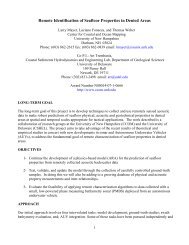EM 2040 Multibeam echo sounder
EM 2040 Multibeam echo sounder
EM 2040 Multibeam echo sounder
You also want an ePaper? Increase the reach of your titles
YUMPU automatically turns print PDFs into web optimized ePapers that Google loves.
<strong>EM</strong> <strong>2040</strong><br />
transducer. The Processing Unit also<br />
supplies power to the transducers.<br />
Operator control, data quality<br />
inspection and data storage is handled<br />
by the hydrographic workstation<br />
running the same SIS software as all<br />
other Kongsberg multibeams.<br />
Operational modes<br />
The <strong>EM</strong> <strong>2040</strong> has a frequency<br />
range of 200-400 kHz. Three<br />
standard modes are available. 300<br />
kHz is used for normal operation,<br />
giving an optimum balance between<br />
high resolution, depth capability<br />
and tolerance of detrimental factors<br />
such as water column sediments.<br />
200 kHz is available for meeting<br />
requirements to operate at the<br />
standard hydrographic single beam<br />
Advanced functions<br />
• Frequency range: 200 to 400 kHz<br />
frequency, but also to achieve the best<br />
depth capability. 400 kHz is provided<br />
for inspection work with the utmost<br />
resolution.<br />
The normally recommended<br />
survey frequency is 300 kHz. At this<br />
frequency the bandwidth used is more<br />
than 75 kHz with three angular sectors<br />
which are run at separate frequencies.<br />
With dual swath six separate<br />
frequencies are used. The minimum<br />
pulselength is 35 microseconds. The<br />
range resolution is then 26 mm. For<br />
deep waters FM chirp is employed<br />
with a bandwidth of 1.7 kHz. This<br />
allows a swath width in the order of<br />
550 m and a depth capability of about<br />
350 m in cold ocean waters.<br />
The 200 kHz frequency mode<br />
has the same CW pulselengths as<br />
the 300 kHz mode. The FM chirp<br />
pulselength is extended compared<br />
to the 300 kHz mode. Normally two<br />
sectors are used per swath. At this<br />
frequency the absorption in the water<br />
is lower than at 300 kHz, resulting<br />
in increased swath width and depth<br />
capability. In cold ocean waters with<br />
FM chirp a swath width of 700 m can<br />
be expected, and approximately 500<br />
m depth capability achieved.<br />
The 400 kHz frequency mode is<br />
intended for high resolution inspection<br />
work. Very short transmit pulses and<br />
wide receiver bandwidth is used. The<br />
operator may choose between one and<br />
three transmit sectors. With a single<br />
RX transducer the coverage can be<br />
up to 120º (±60º), and with dual RX<br />
the coverage can be up to 180º (±90º).<br />
The shortest pulse used is 25 µs. It is<br />
also possible to run dual swath, but<br />
not with the shortest pulse length.<br />
• Dual swath capability, allowing a sufficient sounding density alongtrack<br />
at a reasonable survey speed<br />
• FM chirp allowing much longer range capability<br />
• Complete roll, pitch and yaw stabilization<br />
• Nearfield focusing on both transmit and receive<br />
• Operates with very short pulse lengths, down to 25 microseconds<br />
• The depth rating of the subsea parts is 6000 m<br />
Transducer array (Rx/Tx)<br />
Monitor<br />
HydrographicWork Station (HWS)<br />
Processing Unit (PU)



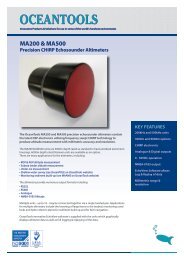

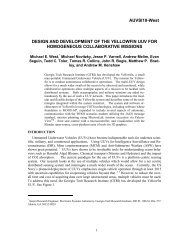
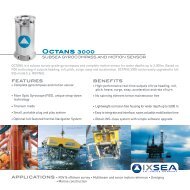
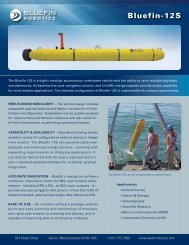
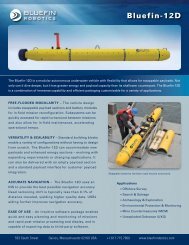


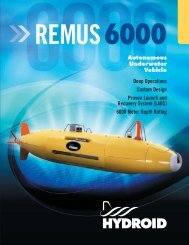


![Sonardyne Wideband Sub-Mini 6 [8270, 8271].pdf - AUVAC](https://img.yumpu.com/44408971/1/190x245/sonardyne-wideband-sub-mini-6-8270-8271pdf-auvac.jpg?quality=85)


